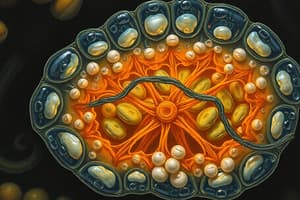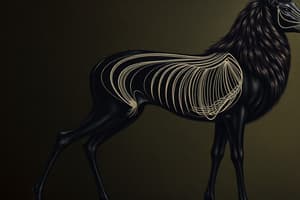Podcast
Questions and Answers
Which kingdom does not contain cells with a nucleus?
Which kingdom does not contain cells with a nucleus?
- Monera (correct)
- Plantae
- Fungi
- Animalia
All members of the kingdom Fungi are multicellular organisms.
All members of the kingdom Fungi are multicellular organisms.
False (B)
What is the main classification for animals that have tissues?
What is the main classification for animals that have tissues?
Eumetazoa
All vertebrates can be categorized under the archetype of a __________.
All vertebrates can be categorized under the archetype of a __________.
Match the following classifications with their characteristics:
Match the following classifications with their characteristics:
Which of the following characteristics applies to all members of the kingdom Animalia?
Which of the following characteristics applies to all members of the kingdom Animalia?
Protozoa are classified under the kingdom Animalia.
Protozoa are classified under the kingdom Animalia.
The ancestral pattern or underlying framework from which different animal forms derive is known as the __________.
The ancestral pattern or underlying framework from which different animal forms derive is known as the __________.
What main system does the endoderm primarily form?
What main system does the endoderm primarily form?
The endoderm contributes to the development of the mouth and anus.
The endoderm contributes to the development of the mouth and anus.
What is the main characteristic of acoelomates?
What is the main characteristic of acoelomates?
Diploblastic organisms, like __________, have only two germ layers.
Diploblastic organisms, like __________, have only two germ layers.
Match the following levels of architectural patterns with their descriptions:
Match the following levels of architectural patterns with their descriptions:
Which type of organism is described as having a basic coelom?
Which type of organism is described as having a basic coelom?
The eucoelomate level represents organisms with true body cavities.
The eucoelomate level represents organisms with true body cavities.
Name an example of a diploblastic organism.
Name an example of a diploblastic organism.
Which characteristic is shared among all phyla?
Which characteristic is shared among all phyla?
Most animal phyla appeared during the Permian period.
Most animal phyla appeared during the Permian period.
What process allowed numerous new animal architectures to emerge?
What process allowed numerous new animal architectures to emerge?
Animals that adapt to their environment and lifestyle show variation in _______.
Animals that adapt to their environment and lifestyle show variation in _______.
Match the following structures to their respective categories:
Match the following structures to their respective categories:
What was a major consequence of the extinction process on animal architectures?
What was a major consequence of the extinction process on animal architectures?
Animal complexity is characterized by a hierarchical organization where each level is less complex than the previous one.
Animal complexity is characterized by a hierarchical organization where each level is less complex than the previous one.
How do habitat and lifestyle affect organisms?
How do habitat and lifestyle affect organisms?
Flashcards are hidden until you start studying
Study Notes
Animal Architecture and Complexity
- Around 100 animal phyla have existed throughout history; only 32 have survived.
- Most phyla emerged approximately 540 million years ago during the Cambrian explosion, a pivotal evolutionary event.
- Many archetypes known today were established in the early Cambrian period along with various others documented only in fossils.
- New life forms began to diversify in low-competition environments, but subsequent speciation mainly produced variations of pre-existing designs.
- Animals possess a shared intrinsic material design and functional model, despite vast differences in structural complexity.
- Organisms are shaped by their habitats and lifestyles, resulting in diverse physical appearances among members of the same group.
Hierarchical Organization of Animal Complexity
- Animal complexity exhibits a hierarchical structure, with each level representing increased complexity compared to the previous one.
- Key characteristics of Animalia include being multicellular, heterotrophic, aerobic (with exceptions), and featuring motility and formation of a blastula.
Phylogenetic Context of Animals
- Phylogenetic trees categorize life forms into groups, including Monera, Plantae, Protista, Fungi, and Animalia.
- Animals are classified into Parazoa (Porifera) and Eumetazoa (true animals with tissues).
Archetypes and Evolutionary Patterns
- An archetype is a fundamental design from which other biological forms evolve.
- Richard Owen's vertebrate archetype illustrates how body shape limits evolutionary possibilities for descendants.
- New evolutionary forms are constrained by the structural and functional limits of their ancestral archetypes.
Architectural Patterns in Animal Evolution
- Evolutionary modifications of basic archetypes enable animals to adapt to varied environments through five developmental levels:
- Level 1: Multicellularity without germ layers (e.g., sponges)
- Level 2: Diploblastic organisms with two germ layers (e.g., cnidarians)
- Level 3: Acoelomates with bilateral symmetry (e.g., flatworms)
- Level 4: Pseudocoelomates with a basic coelom (e.g., nematodes)
- Level 5: Eucoelomates, true coelomates (remaining metazoans)
Summary of Animal Characteristics and Diversity
- Each phylum has distinct biological properties and archetypes, leading to a limited range of life designs due to ancestral heritage.
- Current diversity in animals is shaped by historical evolutionary events and biological adaptations to specific ecological niches.
Studying That Suits You
Use AI to generate personalized quizzes and flashcards to suit your learning preferences.




